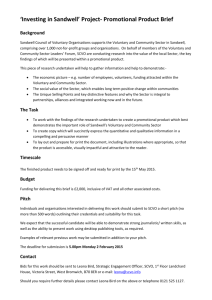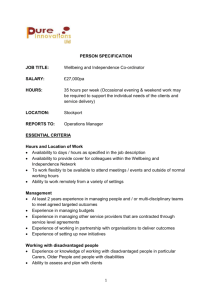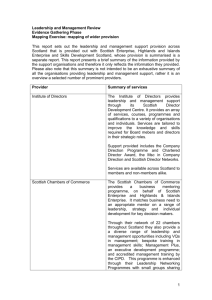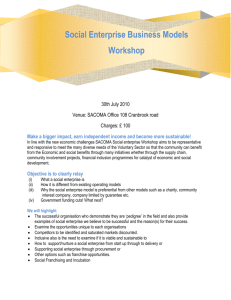Scottish Council for Voluntary Organisations (SCVO)
advertisement
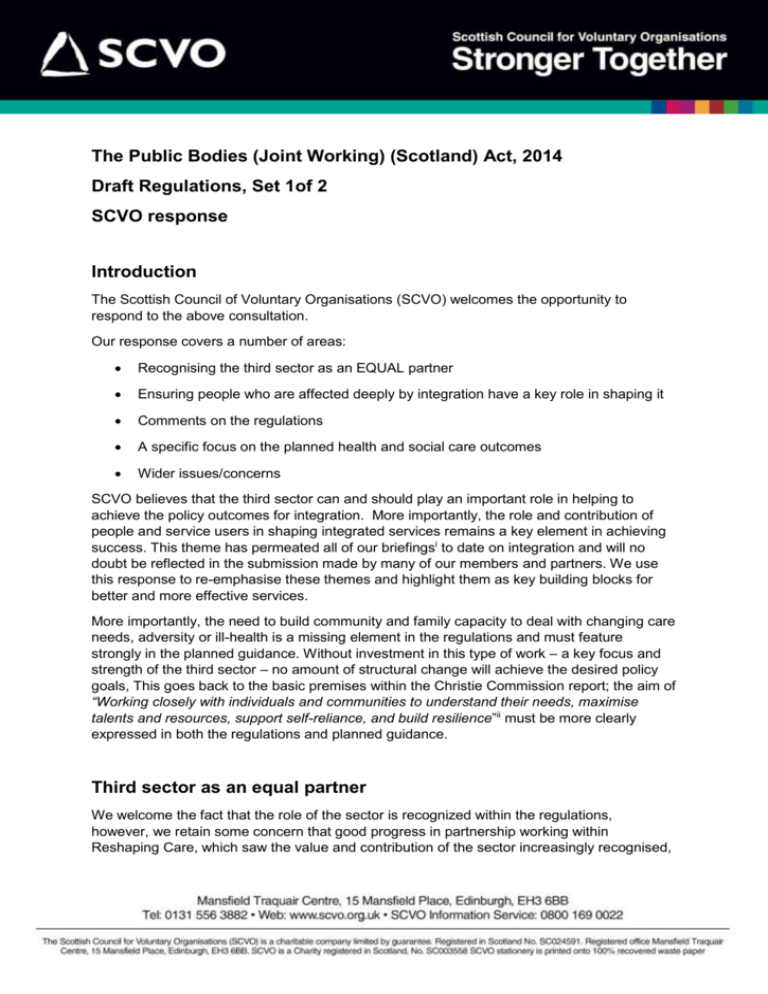
The Public Bodies (Joint Working) (Scotland) Act, 2014 Draft Regulations, Set 1of 2 SCVO response Introduction The Scottish Council of Voluntary Organisations (SCVO) welcomes the opportunity to respond to the above consultation. Our response covers a number of areas: Recognising the third sector as an EQUAL partner Ensuring people who are affected deeply by integration have a key role in shaping it Comments on the regulations A specific focus on the planned health and social care outcomes Wider issues/concerns SCVO believes that the third sector can and should play an important role in helping to achieve the policy outcomes for integration. More importantly, the role and contribution of people and service users in shaping integrated services remains a key element in achieving success. This theme has permeated all of our briefingsi to date on integration and will no doubt be reflected in the submission made by many of our members and partners. We use this response to re-emphasise these themes and highlight them as key building blocks for better and more effective services. More importantly, the need to build community and family capacity to deal with changing care needs, adversity or ill-health is a missing element in the regulations and must feature strongly in the planned guidance. Without investment in this type of work – a key focus and strength of the third sector – no amount of structural change will achieve the desired policy goals, This goes back to the basic premises within the Christie Commission report; the aim of “Working closely with individuals and communities to understand their needs, maximise talents and resources, support self-reliance, and build resilience”ii must be more clearly expressed in both the regulations and planned guidance. Third sector as an equal partner We welcome the fact that the role of the sector is recognized within the regulations, however, we retain some concern that good progress in partnership working within Reshaping Care, which saw the value and contribution of the sector increasingly recognised, may be lost as the focus on funds, boards and structures continues. The sector became a strong partner in reshaping care, and became involved in joint strategic commissioning activity because it was required to sign off the Change Fund plans. That requirement does not exist in relation to integration schemes and so the regulations and guidance must be as strong as possible to ensure participation and involvement of the sector (and service users and carers) is full and honest, and truly impacts on service planning, delivery and evaluation. Without the whole hearted involvement of the sector, the required shift in investment in community capacity is unlikely to happen. Many third sector organisations provide support and services which lead to positive health and wellbeing outcomes – they are an essential part of the health and social care landscape e.g. peer support, lunch clubs, food/shopping projects, older people’s social groups, community transport, support for vulnerable adults, carer support etc. Their work is largely preventative in nature and can enable people to be less dependent on statutory services. Successful strategic and locality planning must understand and involve this totality of resource if we are to gain a clear picture of need and provision – and gaps in support – in each integration board area. The work being taken forward by SCVO and the Scottish Government in East Dunbartonshire will be an important test bed for investment in community services and supportsiii – and the success of challenge funds targeted at the sector through RCOP will also provide important learning for the new Health and Social Care partnerships. Supporting capacity to engage with integration We must ensure that development opportunities offered to councillors and public sector professionals to enable them to participate on integration boards/monitoring committees and strategic and locality planning must also be offered to the third sector and to service users and carers. Whilst progress in recognition of the third sector input into strategic planning has been made, there are still challenges in relation to the views, experience and contribution of the sector being give true parity of esteemiv - not just in planning but also in monitoring progress and in reporting on the final agreed outcomes and indicators. Support must be in place to enable sector representatives to play a full part in shaping integrated services. National organisations such British Heart Foundation, Red Cross, Parkinsons UK and others have a key contribution to make as well as bringing additional resources to the table. If there is no third sector ‘focal point’ in the strategic planning bodies and at locality level, how do they connect? We must find ways to ensure the expertise and knowledge they bring can be fed into all integration partnerships in ways which recognize their capacity and reach. Service Users and Carers at the Heart We must ensure that the voice of carers and service users are at the table and are supported to help shape the very services which connect so deeply with their lives. Their role on integration boards/joint monitoring committees will involve scrutinizing and holding board and key players to account as well as bringing relevant expertise. But at all levels, this involvement (not just engagement) must be effectively supported. 2 More importantly, the regulations must require partnerships not just to outline involvement plans but also demonstrate how they have used this activity to shape their plans. The involvement of key groups beyond statutory partners must make a difference. The need to provide a support infrastructure to enable effective involvement will be stressed in responses from many SCVO members and other intermediary organisations. As highlighted in a briefing from the National Carer Organisations, there must be: “..mechanisms to ensure carers can be involved meaningfully in Integration… boards e.g. expenses, training and appropriate support would apply equally to carer involvement in strategic planning groups.”v The regulations and subsequent guidance must use the strongest possible language on this issue. More importantly, the results within the recent Health and Care Experience Survey provide a strong impetus for ensuring that service users and carers take centre-stage in planning, delivery and monitoring of integrated services. Given a significant proportion (41%) of people receive care and support informallyvi (probably from family, friends and the voluntary sector), how we support and enhance community and family capacity must be a key part of shaping integrated services. Informal support is a significant part of the health and care infrastructure, with family care effectively saving the economy and public finances over £10 billion each yearvii. Prescribed Information Our main comments mirror previous observations about the technical focus of the integration legislation and the draft regulations. There is very little focus on or specific mention of people affected by integration of health and social care within the regulations. Participation and engagement must be a central part of integration schemes and of planning to bring services and funding together. Without genuine co-production from the outset, the outcomes envisioned are unlikely to be achieved. See points above. Impact Assessments There is no mention of Equality Impact Assessments within the regulations. We would also suggest using the word “outcomes” within the sections on performance given the drive to link integration to wider health and wellbeing outcomes. Moving from outputs to outcomes is a welcome move – the language within regulations and guidance needs to better reflect this shift. Plans for workforce development: As outlined above, we would wish to see third sector professionals being supported to take part in shaping integration. There should be support and development opportunities to ensure they are aware of the changes in hand and ways in which this might affect them/how they might get directly involved. The role of Third Sector Interfaces will be critical. We must not assume that all key groups are aware of the planned changes. 3 In the same way as local authorities and third sector colleagues have undertaken joint development activities around welfare reform, we envisage similar approaches may be necessary for integration given the scale of change which may take place and its wider impact on a range of third sector organisations. Data Sharing: As partnerships put in place data sharing accords/protocols, it’s vital that this work is done with third sector partners who play a critical role in health and social care provision. Complaints: Integration presents an opportunity to streamline already complex complaint systems around social care and health. The regulations must specify clarity and accessibility within complaints procedures. There must also be scope for groups of people to raise concerns about care and support, highlighted at a recent event at the Alliance.viii Opportunities to highlight services and approaches which work well could also be encouraged. We will watch the planned development of a “Care Opinion”ix website to mirror Patient Opinion, with interest. For those who have real concerns about how care and support are delivered, the resolution of those concerns are paramount. The impact of this new development on the third sector, given its significant contribution to social care, will be an important consideration. Lastly, how the schemes, plans and changes in structure, services and any delivery are communicated to people is critical. The integration schemes must include communication plans and across all activity, actions must be identified to ensure people are aware of the planned changes and potential implications. Prescribed Functions At the very beginning of the consultation process which led to the Public Bodies bill being enacted, SCVO raised concerns about the business impact for third sector organisations. In responding to the Business Regulatory Impact Assessmentx we outlined a number of points. We revisit some of these with the draft regulations in mind: Integration could lead to a shifting operating environment for third sector organisations if e.g. funding and responsibility for delivery shifts from social care to the NHS or vice versa. Operating within a different business culture could have data sharing implications, will impact on the workforce and may affect governance. As local partnerships agree “integrated” functions and interventions, the impact on the sector could be substantial. Some of the functions prescribed in the regulations include services directly delivered by the third sector and in some cases, services and interventions are funded directly by the Scottish Government via the third sector e.g. Take a Break respite funding/projects. Such services and supports may not be provided by traditional ‘providers’ but by e.g. condition specific, carer and disability organisations of all different sizes/in different localities. 4 It seems likely that statutory partners bringing together “integrated budgets” will review existing spend and seek to make savings. In this context, we believe there is a risk that voluntary organisations might see further rationalisation of local spend and cuts rather than increased investment in the type of activities which can help people to stay well and connected to their communities. Any services which receive funding both from health boards and local authorities may be at risk. We may also see the “drawing in” of services from the third sector back into the largely public sector operated integration functions. We would raise questions about the regulations which highlight that health board functions may “only delegated to extent that they are exercised in relation to health care services”. It’s not immediately clear what this means and it raises doubts that some key health services which can help people to maintain or retain independence may not be delegated – i.e. stay out with the integrated services framework e.g. district nursing, continence services, addiction services, community mental health. Health and Wellbeing Outcomes The prescription of outcomes related to health and wellbeing must be seen as a welcome move. SCVO recognises and welcomes the work to develop outcomes thus far, including direct input from the third sector. However, in line with many third sector colleagues we are concerned that the language and tone within the draft outcomes does not fully reflect the Christie Vision; that the outcomes can be seen as passive and not truly aspirational. Our main contention is this – the fact that the outcomes will be legally binding should not limit our ambitions for them. We fully support calls for the outcomes to more clearly reflect a rights and asset based approach made articulately by Voluntary Health Scotland, the Health and Social Care Alliance and other third sector partners. The Christie Vision: As the Public Bodies Bill developed, and made its way through parliament, there have been questions about how far the legislation reflected the Christie vision for Public Service Reform. It’s worth restating that vision and questioning how far this is reflected within the regulations: public services that are built around people and communities, their needs, aspirations, capacities and skills, and which work to build up their autonomy and resilience; public service organisations prioritise prevention, reduce inequalities and promote equality; and public services which are open, transparent and accountable. 5 Whilst we recognise the wide involvement in shaping the outcomes, discussion across the third sector has enabled us to identify some common concerns about the draft outcomes as they currently stand: There is concern that the outcomes maintain the divide between health and social care There was a consensus that the language used in the outcomes should be more empowering and rights based, and that they should aim to be more positive and aspirational There was concern that the outcomes do not reflect the risk enablement agenda, and the choice and control being promoted through SDS. Giving people more say and involvement in how these services are shaped is vital. It was acknowledged that none of the outcomes are absolute, in that they will never be completely achieved, but that they are a means for measuring progress. Given this it would seem to support taking a more aspirational approach The Community Empowerment Bill and Public Bodies (Joint Working) Act should be clearly linked. The notion of empowering service users and carers must be strongly reflected. It was agreed that it would be helpful to build in the idea that people themselves are part of ‘social capital’ – how they contribute to their own health and wellbeing and t the wellbeing of others. While it was acknowledged that we needed to avoid a duplication of legislation the point was made that the SDS legislation does not apply to health but that the Public Bodies Act does. This would therefore support some read across between this legislation and SDS legislation, particularly in ensuring principles and ideas outlined above are better reflected in the regulations. There is also wide third sector consent on new wording to strengthen the draft outcomes, in line with the arguments made above. We need to ensure that the outcomes send a clear message about the intention and direction of travel for integration of health and social care: Outcome 1 People are able to look after and improve their own health and wellbeing and live in good health for longer, supported by accessible information and support. Outcome 2 People are able to live as far as reasonably practicable, independently and at home or in homely setting in their community and to have access to effective end of life care at home. Outcome 3 People who use health and social care services have positive experiences of those services, have their views listened to and acted on and their right to dignity respected. Outcome 4 Health and social care services respect the rights of individuals, are centred on helping to maintain or improve the quality of life of service users, and support them to contribute to their communities. Outcome 5 Health and social care services contribute to preventing, reducing and undoing health inequalities 6 Outcome 6 People who provide unpaid care have their rights respected and are supported to reduce the potential negative impact that their caring role has on their health and wellbeing and to enable them to maintain a life outside of caring. Outcome 7 People who use health and social care services are safe from harm, are not overprotected and are supported to achieve personal autonomy and choice. Outcome 8 People who work in health and social care services are supported to work in partnership to continuously improve the information, support, care and treatment they provide and feel engaged with the work they do; this must include working closely with service users and carers. Outcome 9 Resources are used effectively in the provision of health and social care services to improve outcomes for people. The link between the final outcomes and joint strategic commissioning must be clear and filter down to actual procurement practice. How these outcomes link to the planned development of the new Scottish Independent Living Fund is also important. Finally, the contribution of the sector in measuring the final outcomes must be fully acknowledged. Without taking account of evaluation and the impact of key third sector supports and services, there cannot be a full understanding of what integrated services are achieving and their impact – good or bad – on people’s lives. Wider application of outcomes The outcomes themselves present an opportunity to rethink and consolidate the range of measures around health and wellbeing. The strong focus in ministerial statements on delayed discharges sadly diminishes the opportunity to consider holistically the range of health challenges which Scotland faces. It also means that integration is progressing within a context which still focusses on illness rather than having a starting point where the end goal is to ensure health and social care play a significant role in helping people’s aspirations for themselves, their links to society and to the economy. We recently made this argument in our response to Scottish Labour’s Health Inequalities policy review. Shifting power back to people There needs to be a much wider argument about power balance and people having far more control over the policies and services which impact on their livesxi. This is acknowledged by the Scottish Government in its’ 20:20 vision which, building on Christie’s recommendations, outlines the need to: shift the balance of power to, and build on the assets of, individuals and communities support the self-management of long-term conditions and personal action, and support partnership working which includes a clear role for the third sector, in Community Planning Partnerships (CPPs) and new Health and Social Care Partnershipsxii. The outcomes must better reflect this vision with more empowering and active language. 7 Rights based approaches SCVO would agree with others who suggest that the outcomes seem to start from a “deficit” perspective. A strong rights based perspective and related language must be used to ensure that the drive towards improving the quality of services and experience of service users is clear from the outset. At a recent session on the regulations held by the Alliance, there was a strong feeling that the tone and direction of the regulations suggests “maintenance’ approaches rather than a focus on enabling people to live full and fulfilling lives – health and in particular, social care services, play a critical role in this regard.xiii There needs to be a stronger emphasis on preventative approaches in service delivery and the positive role that personalisation can play in giving people control over their lives. Partnerships will need to understand how self-directed support is being implemented in the wider framework of services and interventions which come into play within integration. Professionals covered by Act/Regulations Many third sector professionals will be affected by the move towards integrated services and indeed will be key players in providing services. They may be contracted to provide support e.g. carers organisations; provide advice, information, support with self-management, provide food and shopping services, transport etc. There is still a lack of parity of esteem for third sector professionals and the move towards integration provides a significant opportunity to understand their role and impact in achieving health and wellbeing outcomes. How we define ‘social care professionals’ and ‘health professionals’ is important – if the third sector’s work in health and social care is not fully recognised as being within scope then there is a chance that as spending decisions are made by integrated boards/committees, the work of these professionals may be of less value and less likely to be funded - in reality the work they do can be one of the main factors which enable people to stay out of institutional care. As pointed out above, ensuring that the sector can play its role/contribute to the outcomes through its work means that an important part of the jigsaw puzzle is in place early on for planning, commissioning delivery and monitoring of care and support. Care and support needs to be seen in the broadest terms possible. Identifying professionals might start with a consideration of how they contribute to achieving the national health and wellbeing outcomes, once finalised. Other issues The issues of increased charging and of tightening eligibility criteria is yet to be tackled as we move towards regulations and guidance. Integration must not lead to extension of charges – already, charges for lifeline social care services are substantial. Against a backdrop of benefits cuts and cuts to other service e.g. transport, the position of many disabled people and their families is already precarious at best. There is still a great deal of concern about the recent review of continuing care, with 8 more examples emerging of people being charged for essential services, potentially including end of life carexiv. There is still no clarity about the link between the new integrated structures and engagement with these, and Community Planning Partnership. Given the importance of other policy and service areas in achieving health and wellbeing and for the national outcomes that link is critical e.g. decisions to cut local bus services, how green space and housing is planned can all impact on people’s ability to stay well, to remain within their communities and so on . Contact us: Lynn Williams, Policy Officer 0141 559 5036 lynn.williams@scvo.org.uk About us The Scottish Council for Voluntary Organisations (SCVO) is the national body representing the third sector. There are over 45,000 voluntary organisations in Scotland involving around 137,000 paid staff and approximately 1.2 million volunteers. The sector manages an income of £4.4 billion. SCVO works in partnership with the third sector in Scotland to advance our shared values and interests. We have over 1300 members who range from individuals and grassroots groups, to Scotland-wide organisations and intermediary bodies. As the only inclusive representative umbrella organisation for the sector SCVO: has the largest Scotland-wide membership from the sector – our 1300 members include charities, community groups, social enterprises and voluntary organisations of all shapes and sizes our governance and membership structures are democratic and accountable - with an elected board and policy committee from the sector, we are managed by the sector, for the sector brings together organisations and networks connecting across the whole of Scotland SCVO works to support people to take voluntary action to help themselves and others, and to bring about social change. Our policy is determined by a policy committee elected by our members.1 Further details about SCVO can be found at www.scvo.org.uk. 1 SCVO’s Policy Committee has 24 members elected by SCVO’s member organisations who then co-opt up to eight more members primarily to reflect fields of interest which are not otherwise represented. It also includes two ex officio members, the SCVO Convener and Vice Convener. 9 References Scottish Voluntary Sector Statistics 2010, SCVO www.scvo.org.uk/evidencelibrary/Home/ReadResearchItem.aspx?f=asc&rid=1078 i For example - http://www.vhscotland.org.uk/wp-content/uploads/2013/08/Scottish-Council-for-VoluntaryOrganisations.pdf ii http://www.scotland.gov.uk/Publications/2011/06/27154527/2 iii http://www.scvo.org.uk/building-healthier-and-happier-communities/ iv Insight Paper One – Engaging with Reshaping Care, Health and Social Care Alliance, Feb 2014 vwww.carersuk.org/images/Scotland/CarerBriefingRegulationsFinal.pdf vi http://www.scotland.gov.uk/Resource/0045/00451272.pdf vii https://www.carers.org/scotland viii http://www.alliance-scotland.org.uk/news-and-events/news/2014/07/alliance-members-call-for-strengthenedfocus-on-personal-outcomes/#.U8Pt6U1OW70 ix http://www.alliance-scotland.org.uk/news-and-events/news/2014/07/alliance-and-patient-opinion-to-pilot-careopinion-initiative/#.U7Voa01OW70 x Recognised within Scottish Government BRIA - http://www.scotland.gov.uk/Resource/0042/00423477.pdf xi http://www.carnegieuktrust.org.uk/CMSPages/GetFile.aspx?guid=5b79f25d-3771-4b28-8b28-22fadee2356a xii Voluntary Health Scotland – Briefing for Scottish Labour Health Inequality Inquiry xiii http://www.alliance-scotland.org.uk/news-and-events/news/2014/07/alliance-members-call-for-strengthenedfocus-on-personal-outcomes/#.U8Pt6U1OW70 xiv http://www.mndscotland.org.uk/personal-care-charges/ 10
